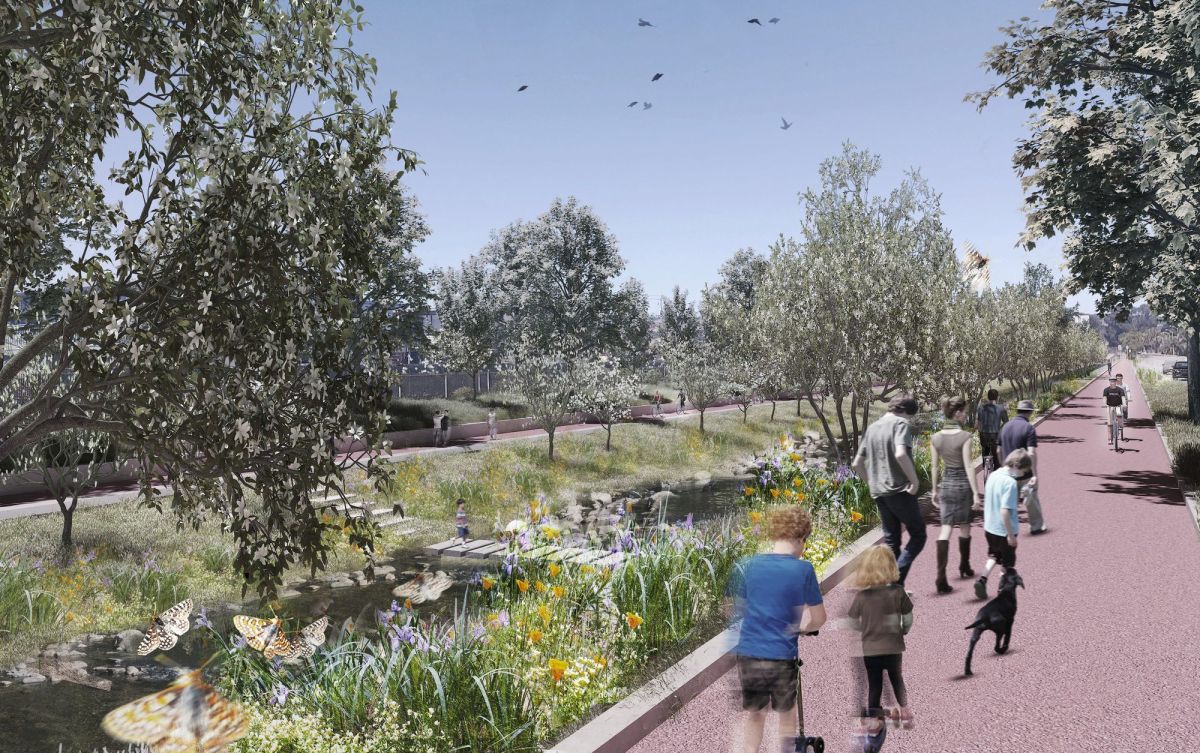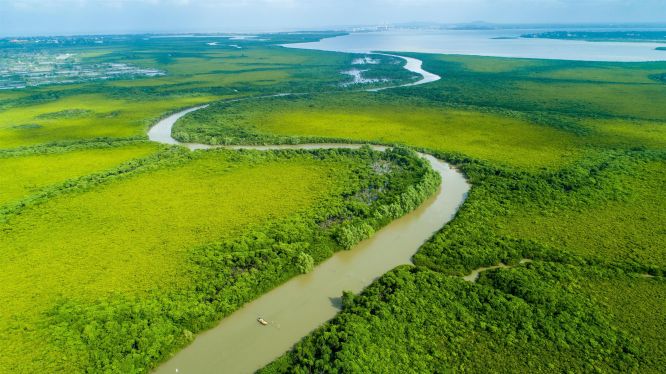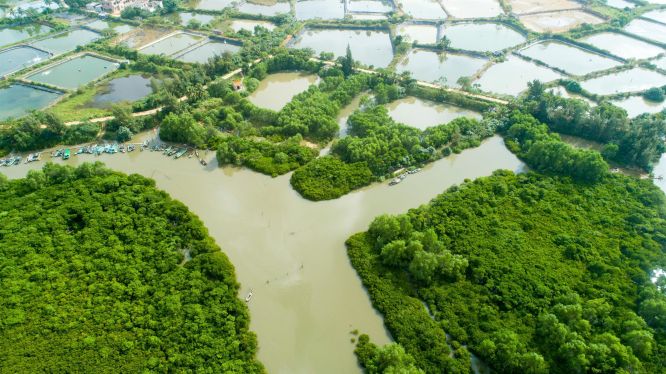A decade for humility in design
We wouldn’t paint a neon moustache on the Mona Lisa. So why do we pave over beautiful and resilient natural systems?
Text and image by Richard Mullane (*edited artwork by Leonardo da Vinci. Source: Alamy)
Some might say contemporary designers have been ‘defacing’ natural systems with heavy-handed projects, just like a vandal might destroy a cherished artwork with a stroke of paint.
The process of restoring our ecology through design requires a certain humility – a sense we’re in the presence of something greater. Something that demands respect and reflection.
That can be a challenge in a profession often caught up in trends, even if they’re detrimental to our natural environment. On top of that, designers can get inspired – and excited – about the form of natural systems without fully understanding their functions or their connection to place.
A few years ago I heard a notable ‘starchitect’ speak about the design of a major tower – a twisting, petal-like form that’s taken shape in a city far from his home. He waxed lyrical about how nature inspired his design for this particular city building, yet the original concept sketch was for a project in another location, where the species of flower was native.
Sound familiar? That’s because it’s not the first time we’ve heard stories like this one in our line of work. I believe it indicates that our increasingly global profession has lost touch with the powerful role nature and context play in design.
THE NEXT DECADE CALLS FOR RESTORATIVE DESIGN
In 2019, the UN called for a decade (2021 to 2030) focused on restoring ecosystems, so we could reverse centuries of damage and create an “unparalleled opportunity for job creation, food security and addressing climate change”.
This proposal presents another great opportunity – to bring humility back to the design profession.
As cities worldwide look to sequester carbon and adapt urban shorelines to manage rising sea levels, we can now see the clear, enduring value of naturally occurring ecosystems.
Restoring those systems requires not just a commitment to repairing damage we’ve done. It means we have to look back at (and learn from) earlier practices to move forward – a real paradigm shift for designers.
RESTORATION IS AS COMPLEX AS MODERN DESIGN
Modern design puts too much value on the ‘new’ at the expense of natural systems. In a profession that has often rewarded simplicity and novelty, we can overlook valuable lessons from the way things worked before our modern age.
To understand humility’s role in restoration, think about how a traditional craftsperson would refurbish antique furniture. Before they did anything, they’d painstakingly research and analyse the way a design was originally put together. In essence, they’d reject our urge today to innovate and instead embrace the complexity and authenticity of the original craft.
Kay Davenport, writing for thewoodwhisperer.com, explains that the art of restoration considers how the act of preservation adds or subtracts from the original work. As she says, if it “changes the work of the master craftsperson… this is like painting a neon moustache onto the Mona Lisa.”
“Ecological restoration, when implemented effectively and sustainably, contributes to protecting biodiversity; improving human health and wellbeing; increasing food and water security; delivering goods, services, and economic prosperity; and supporting climate change mitigation, resilience, and adaptation.”
International Principals and Standards for the Practice of Ecological Restoration
HUMILITY WILL DRIVE THE FUTURE OF DESIGN
Today, some of the most important people working in design see that projects don’t just extract value from a site. They understand their work can and should restore places – addressing specific environmental challenges. And they’re ultimately inspired by those places too.
We can see this in projects that treat urban storm water runoff with constructed wetlands – like the restoration of San Francisco’s South Bay Salt Ponds – or those that protect and expand urban forests to improve air quality, like the Eden Reforestation Program across Africa and Indonesia. The people behind this kind of work are the real masters of our modern design profession.
Ecosystem restoration challenges designers to embrace solutions that may play out over long periods of time instead of opting for a quick fix – an instantly constructed outcome.
Restorative design calls on us to really listen to and involve communities in the design process. To draw on their deep local knowledge. To empower them as custodians of the local environment they know so well. To put them in the driver’s seat to ensure these important projects are not only successfully delivered but also flourish well into the future.
This approach also requires us to take input and advice from experts beyond our own professional circles. For example, the restoration of San Francisco Bay’s ‘Baylands’ – a critical project to protect against projected sea-level rise for the region – is guided by the 300-page 2015 Habitat Restoration Goals – Science Update, which was prepared by over 100 local scientists. This research directs strategies across 20 sub regions of the shoreline, for the restoration of more than 100,000 acres of habitat.
To create outstanding places for the community and build real connections along that shoreline, we absolutely need innovation in design. But approaching the work with humility and a willingness to expand our understanding of local ecosystem needs is the only way to succeed.

LEARNING FROM FIRST PEOPLES AND TRADITIONAL LAND OWNERS
In their proposed decade of ecosystem restoration, the UN specifically links outcomes for the environment and equity as part of their sustainable development goals. They also recognise the many communities that have traditionally been the stewards of landscapes impacted by environmental destruction since the industrial revolution.
Whether they’re agro-ecology farmers along the Mekong or nomadic grazers across the Mongolian Steppe, many communities can reap the benefits of the UN’s proposal. It can restore their purpose and their livelihoods while at the same time building resilience for our connected urban centres.
On the Stadium Park project in Perth, Australia, Hassell’s landscape design team worked closely with the Indigenous Whadjuk people, and particularly their 16 Apical Ancestors who shared powerful stories that inspired creation of the parklands. Once a sewage plant and rubbish tip on the banks of the Swan River, the project now teaches locals those Indigenous stories and shares their knowledge of the resilient, native plants they value so much.
In New Zealand, the rebuilding of Christchurch since the 2011 earthquake includes impressive work from Jasmax and their Maori design voice – Waka Māia. Their practice has woven the insights of Indigenous communities through many different restorative projects there – from active mobility networks to community facilities – making Christchurch a more inclusive, resilient city for the future.


WE CAN PAUSE AND RE-EMERGE RESILIENT AFTER 2020
How will this decade impact our cities and their relationship with nature? It goes without saying that buildings ‘inspired by nature’ – even if it’s by floral petals – can positively impact the aesthetics of our urban environment.
But design needs to go deeper than that. We need to draw on ecological, cultural and Indigenous knowledge to create places and natural systems that mitigate future hazards. We need to create places that support climate adaptation and reduce disaster risk to make our cities more liveable and sustainable – and to enhance positive human connections with nature.
Around the world, many of us are emerging from a shared experience that has reminded us of both the value of nature and the meaning of ‘resilience’. As devastating as COVID-19 has been to our communities, an unforeseen outcome is a sense of optimism about how adaptable we can be in the face of complex challenges.
That opens us up to the possibilities for adapting our communities to face one of our biggest global challenges: climate change. We know it’s possible to change our way of life. We know nature and ecosystems are valuable to our cities. The question is whether our design profession has the humility and skills to help put the pieces together.